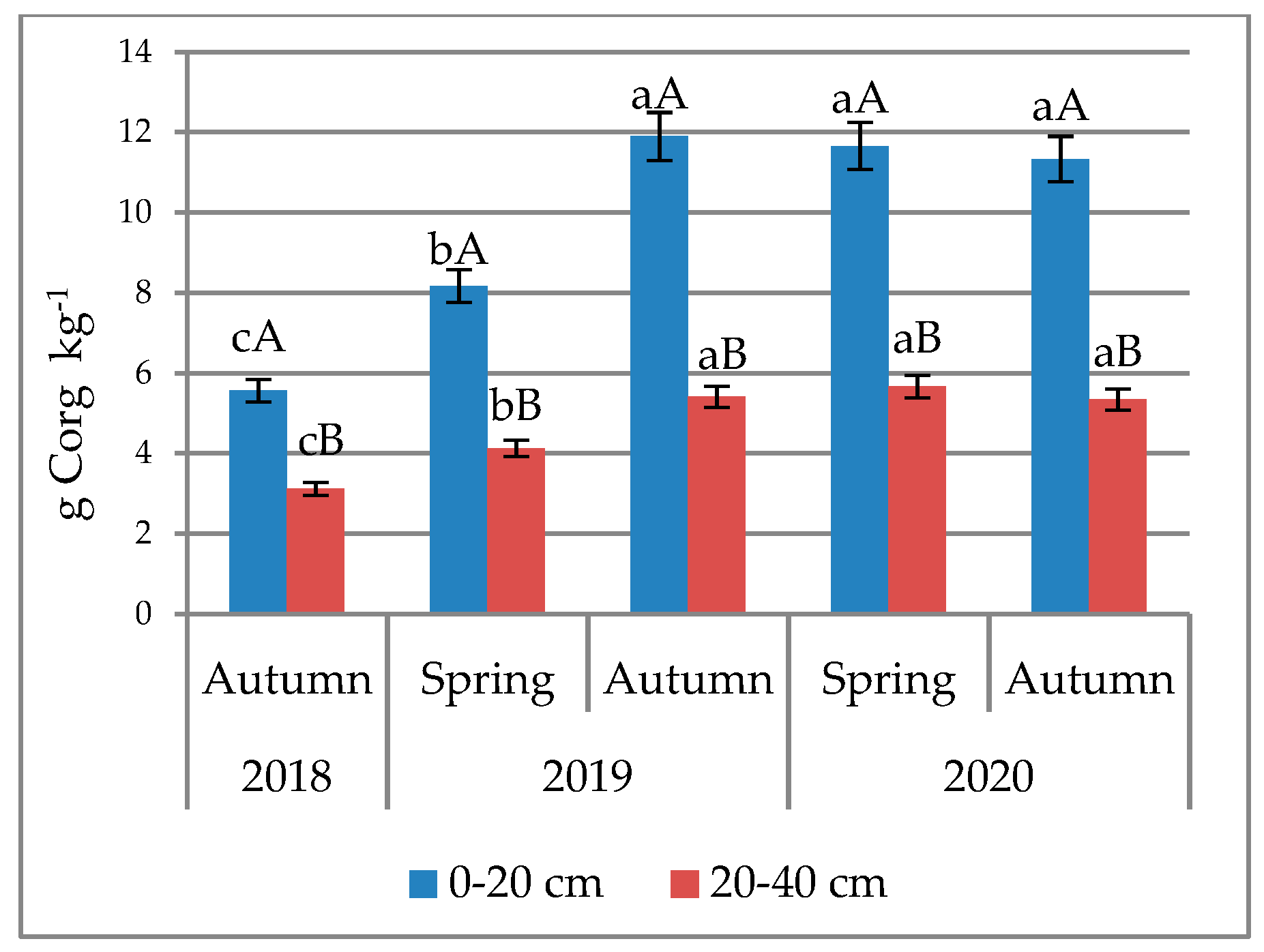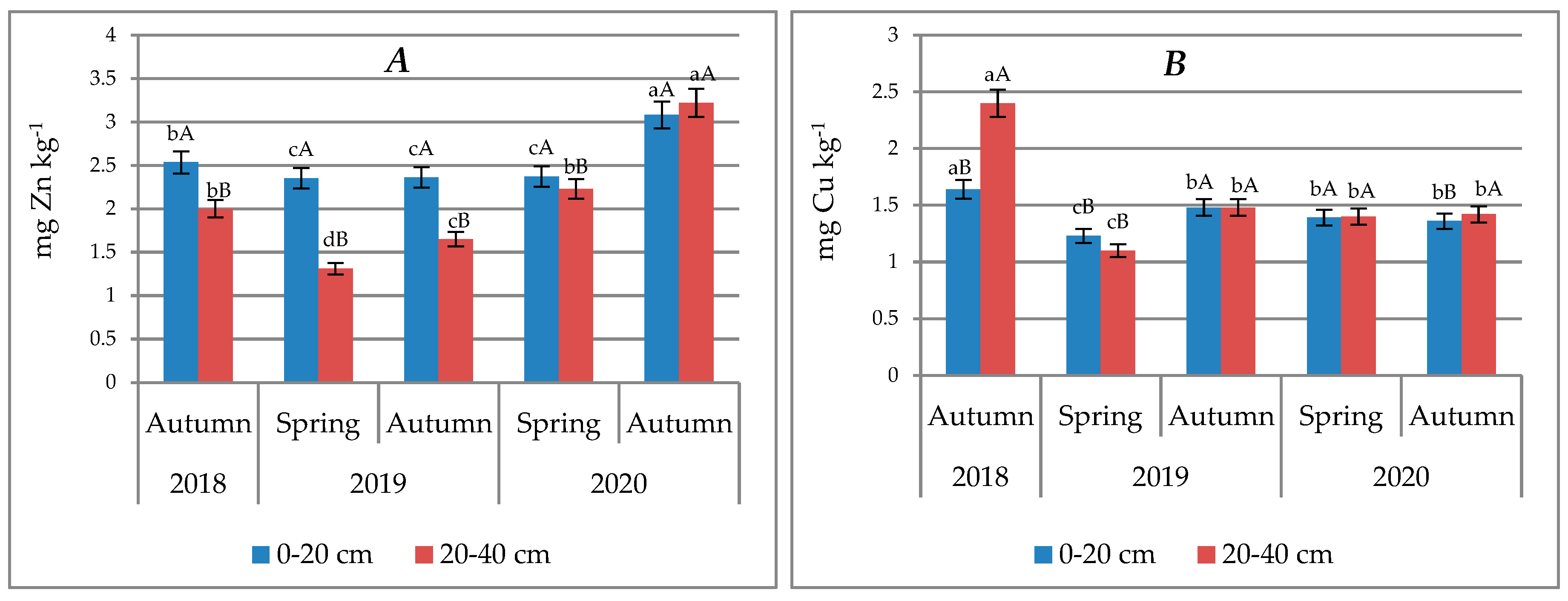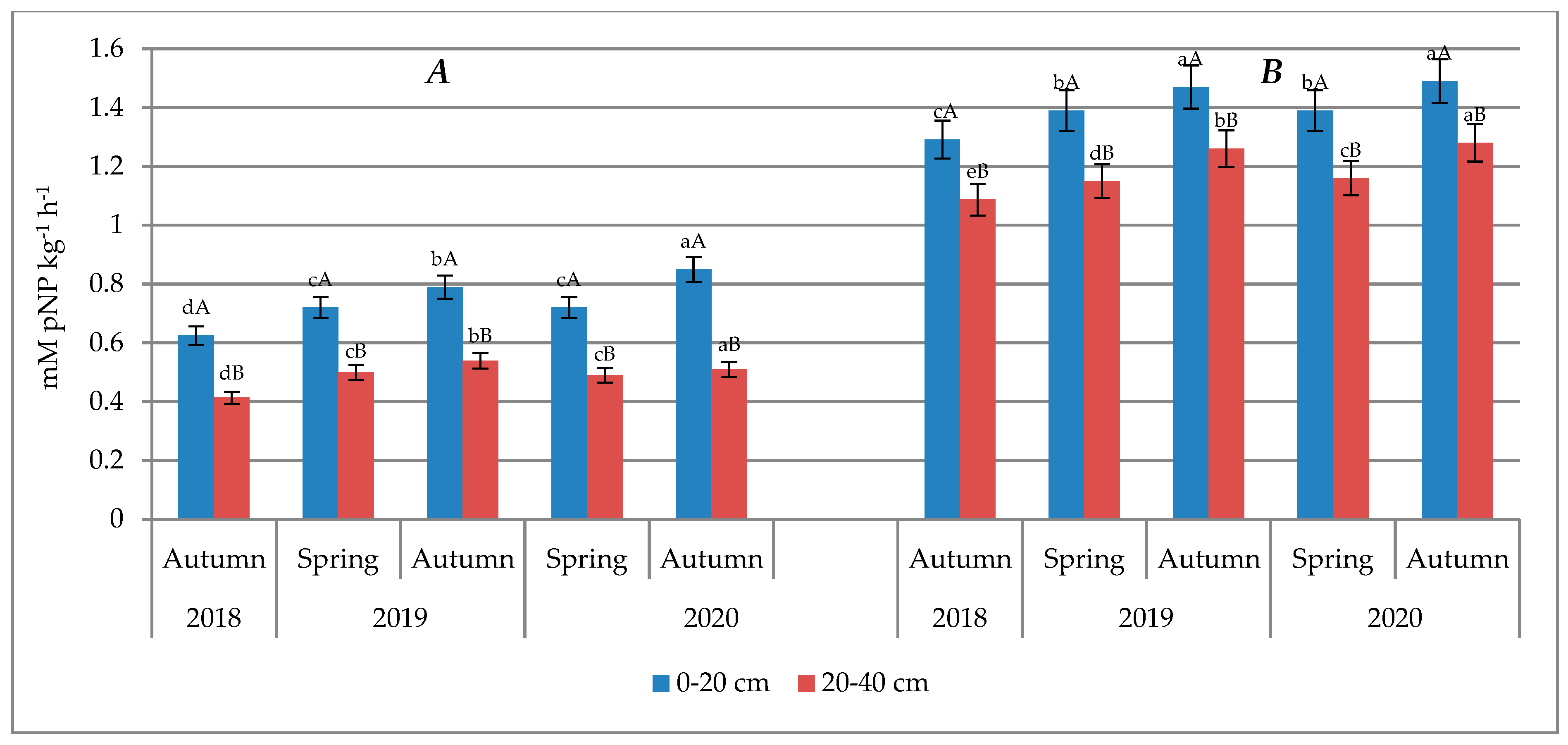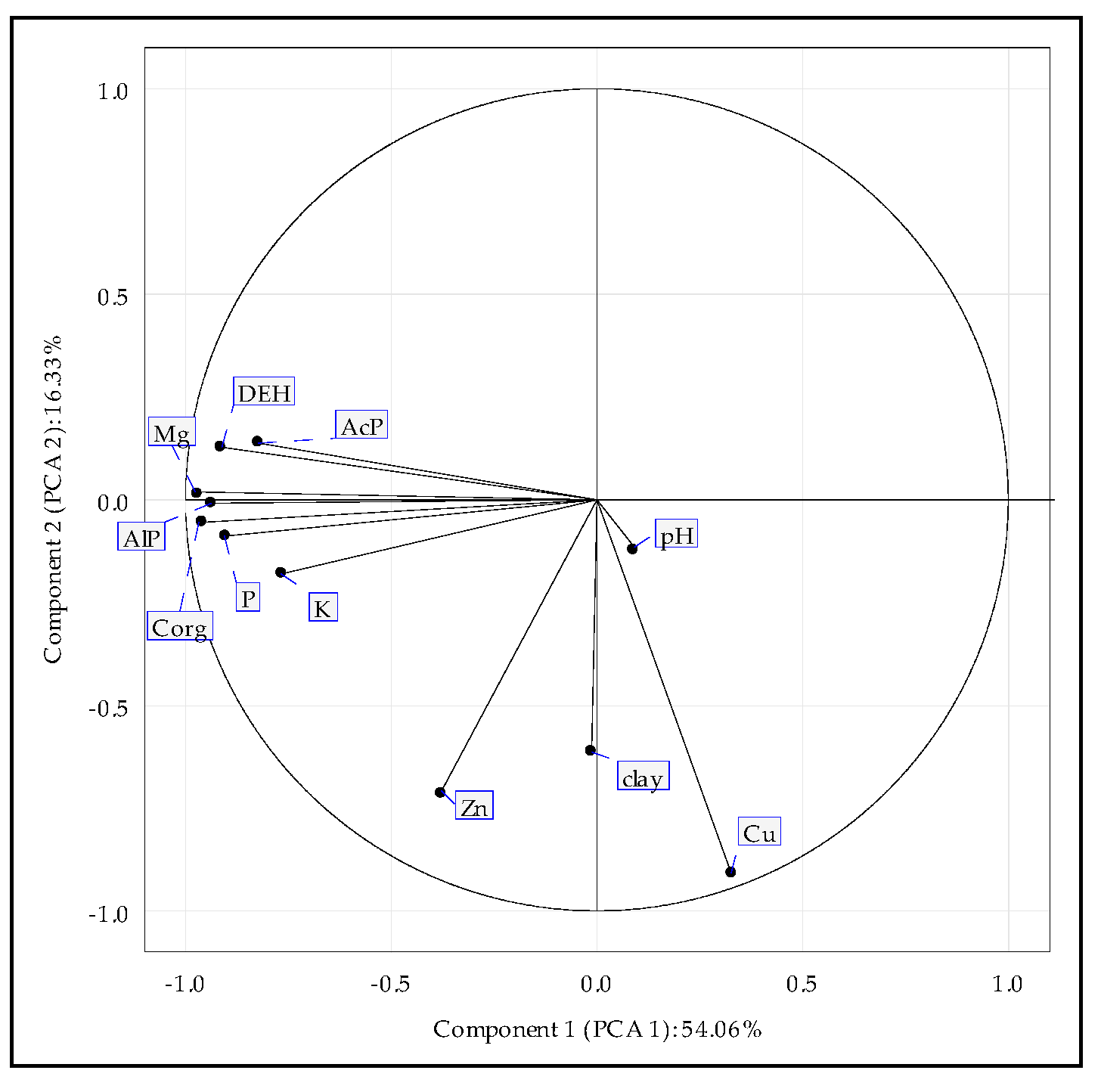Enzymatic Activity of Soil after Applications Distillery Stillage
Abstract
:1. Introduction
2. Materials and Methods
2.1. Location of Soil Sampling
2.2. Soil Analysis
- Soil pH in 1 M KCl [23].
- Organic carbon (Corg) was determined using Tiurin’s method by wet oxidation at 180 °C with a mixture of potassium dichromate and sulfuric acid [24].
- The granulometric composition with the laser diffraction method applying the Masterssizer MS 2000 analyzer.
- The contents of easily available forms of heavy metals (Zn, Cu), DTPA-extracted (1 M diethylenetrianinepentaacetic acid) were also measured, according to Lindsay and Norvell [28]. The content of the available forms of Zn and Cu to soil was determined by atomic absorption spectroscopy using a Solaar S4 spectrometer. To verify the accuracy of the results, the analysis of the certified material Loam Soil No. ERM-CC141 and the so-called zero tests were carried out, which were exposed to the identical analytical procedure as the soil samples. Good comparability between the certified and determined values was obtained.
2.3. Enzyme Analysis
- Dehydrogenases (DEH) activity was determined by Thalmann’s method [29] after incubating the samples with 2,3,5-triphenyltetrazolium chloride and measuring the absorbance of triphenylformazane (TPF) at 546 nm and expressed as mg TPF kg−1 24 h−1.
- The activity of alkaline phosphatase (AlP) and acidic phosphatase (AcP) in the soil was measured based on p-nitrophenol detection (pNP) produced after incubation (at 37 °C, for 1H) at pH~6.5 for AcP and pH~11.0 for AlP [30].
2.4. Statistical Analysis
3. Results and Discussion
4. Conclusions
Author Contributions
Funding
Institutional Review Board Statement
Informed Consent Statement
Data Availability Statement
Acknowledgments
Conflicts of Interest
References
- Regulation of the Minister of Environmental Protection, Natural Resources and Forestry of 24 december 1997 on the classification of waste. J. Laws 1997. No. 162, item 1135.
- Zielińska, M.; Bułkowska, K.; Mikucka, W. Valorization of Distillery Stillage for Bioenergy Production: A Review. Energies 2021, 14, 7235. [Google Scholar] [CrossRef]
- Szulc, W.; Rutkowska, B.; Łabętowicz, J.; Gutowska, A. Distiller slops—Wastage whether the organic fertilizer? Adv. Agric. Sci. Probl. Iss. 2009, 535, 423–433. [Google Scholar]
- Bustamante, M.A.; Perez-Murcia, M.D.; Paredes, C.; Mora, L.R.; Perez-Espinosa, A.; Moreno-Caselles, J. Short-term carbon and nitrogen mineralisation in soil amended with winery and distillery organic wastes. Bioresour. Technol. 2007, 98, 3269–3277. [Google Scholar] [CrossRef] [PubMed]
- Skowrońska, M.; Filipek, T. Fertilizing use of stillage. Proc. Ecopole 2012, 6, 1–5. [Google Scholar] [CrossRef]
- Fuess, L.T.; Rodrigues, I.J.; Zaiat, M.; Garcia, M.L. Fertigation with sugarcane stillage: Potential impacts on soil and water resources. In Proceedings of the IV Symposium on Agricultural and Agroindustrial Waste Management, Rio de Janeiro, Brazil, 5–7 May 2015. [Google Scholar]
- Ratna, S.; Rastogi, S.; Kumar, R. Current trends for distillery wastewater management and its emerging applications for sustainable environment. J. Environ. Manag. 2021, 290, 112544. [Google Scholar] [CrossRef] [PubMed]
- Ryznar-Luty, A.; Cibis, E.; Krzywonos, M. Methods of vinasse utilisation: Industrial applications and laboratory scale research. Arch. Waste Manag. Environ. Protec. 2009, 11, 19–32. [Google Scholar]
- Carrilho, E.N.V.M.; Labuto, G.; Kamogawa, M.Y. Destination of vinasse, a residue from alcohol industry: Resource recovery and prevention of pollution. In Environmental Materials and Waste: Resource Recovery and Pollution Prevention; Prasad, M.N.V., Kaimin, S., Eds.; Elsevier Inc.: Amsterdam, The Netherlands, 2016; pp. 21–43. [Google Scholar] [CrossRef]
- Tejeda, M.; Moreno, J.L.; Hernandez, M.T.; Garcia, C. Application of two beet vinasse forms in soil restoration: Effects on soil properties in an arid environment in southern Spain. Agric. Ecosyst. Environ. 2007, 119, 289–298. [Google Scholar] [CrossRef]
- Parnaudeau, V.; Condom, N.; Oliver, R.; Cazevieille, P.; Recous, S. Vinasse organic matter quality and mineralization potential, as influenced by raw material, fermentation and concentration processes. Bioresour. Technol. 2008, 2, 1553–1562. [Google Scholar] [CrossRef]
- Mutton, M.A.; Rossetto, R.; Rossini Mutton, M.J.R. Agricultural use of Stillage. In Sugarcane Bioethanol—R&D for Productivity and Sustainability; Cortez, L.A.B., Ed.; Editora Edgard Blücher: São Paulo, Philippines, 2014; pp. 423–440. [Google Scholar]
- Baskar, M.; Saravanan, A.; Chithra, L.; Dhevagi, P.; Lenin Raja, D.; Pandiyarajan, P.; Ambast, S.K. Ecofriendly Utilisation of Distillery Waste Water in Agriculture; Tamil Nadu Agricultural University: Tiruchirapalli, India, 2013; pp. 1–57. [Google Scholar]
- Alotaibi, K.D.; Schoenau, J.J.; Hao, X. Fertilizer potential of thin stillage from wheat-based ethanol production. BioEnergy Res. 2014, 7, 1421–1429. [Google Scholar] [CrossRef]
- Kumari, K.; Ranjan, N.; Kumar, S.; Sinha, R.C. Distillery effluent as a liquid fertilizer: A win-win option for sustainable agriculture. Environ. Technol. 2016, 37, 381–387. [Google Scholar] [CrossRef] [PubMed]
- Gahlot, D.K.; Kukreja, K.; Suneja, S.; Dudeja, S.S. Effect of digested distillery spent wash on nodulation, nutrient uptake and photosynthetic activity in chickpea. Acta Agron. Hung. 2011, 59, 73–85. [Google Scholar] [CrossRef]
- Nandy, T.; Shastri, S.; Kaul, S.N. Wastewater management in a cane molasses distillery involving bioresource recovery. J. Environ. Manag. 2002, 65, 25–38. [Google Scholar] [CrossRef] [PubMed]
- Lemanowicz, J.; Haddad, S.A.; Bartkowiak, A.; Lamparski, R.; Wojewódzki, P. The role of an urban park’s tree stand in shaping the enzymatic activity, glomalin content and physicochemical properties of soil. Sci. Total. Environ. 2020, 741, 140446. [Google Scholar] [CrossRef] [PubMed]
- Jaskulska, I.; Lemanowicz, J.; Breza-Boruta, B.; Siwik-Ziomek, A.; Radziemska, M.; Dariusz, J.; Białek, M. Chemical and biological properties of sandy loam soil in response to long-term organic–mineral fertilisation in a warm-summer humid continental climate. Agronomy 2020, 10, 1610. [Google Scholar] [CrossRef]
- Kaur, J.; Singh, H.; Benbi, D.; Sharma, S.; Banta, G. Effect of distillery effluent, biomethanated spent wash, on microbial activity parameters in soil under rice-wheat cropping system. Proc. Natl. Acad. Sci. India Sect. B Biol. Sci. 2017, 87, 467–475. [Google Scholar] [CrossRef]
- Hassan, U.M.; Aamer, M.; Umer Chattha, M.; Haiying, T.; Khan, I.; Seleiman, M.F.; Rasheed, A.; Nawaz, M.; Rehman, A.; Talha Aslam, M.; et al. Sugarcane distillery spent wash (DSW) as a bio-nutrient supplement: A win-win option for sustainable crop production. Agronomy 2021, 11, 183. [Google Scholar] [CrossRef]
- IUSS Working Group WRB. World Soil Resources Reports No. 106. In World Reference Base for Soil Resources; FAO: Rome, Italy, 2014. [Google Scholar]
- PN-ISO 10390; Chemical and Agricultural Analysis: Determining Soil pH. Polish Standards Committee: Warszawa, Poland, 1997.
- PN-ISO 14235; Chemical and Agricultural Analysis—Soil Quality—Determining the Content of Organic Carbon by Oxidation of Potassium Dichromate (VI) in the Environment of Sulphuric acid (VI). Polish Standards Committee: Warsaw, Poland, 2003.
- PN-R-04023; Chemical and Agricultural Analysis—Determination of the Content of Available Phosphorus in Mineral Soils. Polish Standards Committee: Warszawa, Poland, 1996.
- PN-R-04022; Chemical and Agricultural Analysis—Determination of the Content Available Potassium in Mineral Soils. Polish Standards Committee: Warszawa, Poland, 1996.
- PN-R-04020; Chemical and Agricultural Analysis. Determination of the Content Available Magnesium. Polish Standards Committee: Warszawa, Poland, 1994.
- Lindsay, W.L.; Norvell, W.A. Development of a DTPA soil test for zinc, iron, manganese, copper. Soil Sci. Soc. Am. J. 1978, 43, 421–428. [Google Scholar] [CrossRef]
- Thalmann, A. Zur methodic derestimung der Dehydrogenaseaktivität und Boden mittels Triphenyltetrazoliumchlorid (TTC). Landwirtsch. Forsch 1968, 21, 249–258. [Google Scholar]
- Tabatabai, M.A.; Bremner, J.M. Use of p–nitrophenol phosphate for assay of soil phosphatase activity. Soil Biol. Biochem. 1969, 1, 301–307. [Google Scholar] [CrossRef]
- Wilding, L.P. Spatial variability: Its documentation, accommodation, and implication to soil surveys. In Soil Spatial Variability, 1st ed.; Nielsen, D.R., Bouma, J., Eds.; CRC Press: Wageningen, The Netherlands, 1985; pp. 166–194. [Google Scholar]
- USDA. Keys to Soil Taxonomy, 10th ed.; United States Department of Agriculture, Natural Resources Conservation Service: Washington, DC, USA, 2006; pp. 1–332.
- PTG. Particle size distribution and textural classes of soil and mineral materials—Classification of Polish Society of Soil Sciences 2008. Soil Sci. Annu. 2009, 60, 5–16. [Google Scholar]
- Whalen, J.K.; Chang, C.; Clayton, G.W.; Carefoot, J.P. Cattle manure amendments can increase the pH of acid soils. Soil Sci. Soc. Am. J. 2000, 64, 962–966. [Google Scholar] [CrossRef] [Green Version]
- Robles-González, V.; Galíndez-Mayer, J.; Rinderknecht-Seijas, N.; Poggi-Varaldo, H.M. Treatment of mescal vinasses: A review. J. Biotechnol. 2012, 157, 524–546. [Google Scholar] [CrossRef] [PubMed]
- Kabaloev, T.X.; Dzanagov, S.C.; Bekuzarova, S.A.; Subbotin, I.M.; Esenov, I.K. Use of distillery waste as a fertilizer. J. Pharm. Sci. Res. 2018, 10, 2314–2316. [Google Scholar]
- Gonet, S.S. Organic matter in the European Union thematic strategy on soil protection. Rocz. Glebozn. Soil Sci. Annu. 2007, 58, 15–26. [Google Scholar]
- Deshpande, A.N.; Kamble, B.M.; Shinde, R.B.; Gore, S.B. Effect of primary treated biomethanated spent wash on soil propertiesand yield of sunflower (Helianthus annuus L.) on sodic soil. Commun. Soil Sci. Plant Anal. 2012, 43, 730–743. [Google Scholar] [CrossRef]
- Slyusareva, V.N.; Osipova, A.V.; Vlasenko, V.P. Application of wine and brandy distillery stillage to southern chernozem soils of the taman peninsula: Agroecological aspects. Russian Agric. Sci. 2020, 46, 591–595. [Google Scholar] [CrossRef]
- Pranagal, J. The effect of tillage system on organic carbon content in the soil. Ann. UMCS Ses. E. 2004, 59, 1–10. [Google Scholar]
- Kwiatkowska-Malina, J. Qualitative and quantitative soil organic matter estimation for sustainable soil management. J. Soils Sediment. 2018, 18, 2801–2812. [Google Scholar] [CrossRef] [Green Version]
- Lemanowicz, J. Phosphorus content and distribution and the activity of phosphatases in Arenosols in forest affected by long-term exposure to the effects of the Nitrogen Works Anwil in Włocławek. For. Res. Pap. 2015, 76, 250–255. [Google Scholar] [CrossRef] [Green Version]
- Mortvedt, J.J.; Cox, F.R.; Shuman, L.M.; Welch, R.M.; Mickelson, S.H.; Luxmoore, R.J.; Miller, F.P. Micronutrients in Agriculture; Soil Science Society of America, Inc.: Madison, WI, USA, 1991. [Google Scholar]
- Ramalho, J.F.G.P.; Sobrinho, N.M.B.A. Heavy metals in soils cultivated with sugar cane by the use of agro-industrial residues. Floresta E Ambiente 2001, 8, 120–129. [Google Scholar]
- Jobbágy, E.G.; Jackson, R.B. The distribution of soil nutrients with depth: Global patterns and the imprint of plants. Biogeochemistry 2001, 53, 51–77. [Google Scholar] [CrossRef]
- Wojewódzki, P.; Lemanowicz, J.; Debska, B.; Haddad, S.A. Soil enzyme activity response under the amendment of different types of biochar. Agronomy 2022, 12, 569. [Google Scholar] [CrossRef]
- Dick, W.A.; Cheng, L.; Wang, P. Soil acid and alkaline phosphatase activity as pH adjustment indicators. Soil Biol. Biochem. 2000, 32, 1915–1919. [Google Scholar] [CrossRef]
- Furtak, K.; Gajda, M.A. Activity of dehydrogenases as an indicator of soil environment quality. Pol. J. Soil Sci. 2017, 50, 33–40. [Google Scholar] [CrossRef] [Green Version]
- Bartkowiak, A.; Lemanowicz, J.; Kobierski, M. The content of macro- and microelements and the phosphatase activity of soils under a varied plant cultivation technology. Eurasian Soil Sc. 2015, 48, 1354–1360. [Google Scholar] [CrossRef]
- Rusecki, H.; Skowrońska, M.; Chojnacka, S.; Kraska, P.; Andruszczak, S.; Mocek-Płóciniak, A. Fertilizing potential of rye stillage in a maize agroecosystem. Agronomy 2019, 9, 688. [Google Scholar] [CrossRef] [Green Version]







| pH | N | P | K | Mg | Zn | Cu |
|---|---|---|---|---|---|---|
| g L−1 | mg L−1 | |||||
| 3.8 | 2.56 | 1.38 | 12.6 | 1.95 | 4.21 | 0.76 |
| Parameters * | Depth (cm) | Min * | Max * | Me * | CV * |
|---|---|---|---|---|---|
| Clay % | 0–20 20–40 | 6.07 5.48 | 9.83 8.45 | 7.00 7.28 | 15.35 17.04 |
| pH | 0–20 20–40 | 4.42 5.03 | 6.37 6.58 | 5.83 5.74 | 11.78 8.42 |
| Corg g kg−1 | 0–20 20–40 | 3.9 1.30 | 7.7 5.25 | 4.45 3.00 | 27.93 40.24 |
| P mg kg−1 | 0–20 20–40 | 5.59 0.18 | 67.80 14.98 | 15.30 4.35 | 84.62 96.00 |
| K mg kg−1 | 0–20 20–40 | 100 65.75 | 243 102 | 148 95.40 | 23.85 14.50 |
| Mg mg kg−1 | 0–20 20–40 | 68.94 40.22 | 98.52 68.23 | 74.99 56.75 | 80.28 16.19 |
| Zn mg kg−1 | 0–20 20–40 | 1.63 1.07 | 3.44 3.79 | 2.59 1.41 | 19.12 55.42 |
| Cu mg kg−1 | 0–20 20–40 | 0.86 0.90 | 2.22 5.83 | 1.73 1.89 | 28.85 69.09 |
| AlP mMpNP kg−1 h−1 | 0–20 20–40 | 0.35 0.22 | 1.01 0.62 | 0.57 0.39 | 33.49 29.68 |
| AcP mMpNP kg−1 h−1 | 0–20 20–40 | 1.07 0.76 | 1.71 1.45 | 1.16 1.04 | 17.98 21.88 |
| DEH mgTPF kg−1 24 h−1 | 0–20 20–40 | 0.99 0.52 | 1.23 0.96 | 1.11 0.74 | 6.84 22.13 |
| Parameters * | Depth cm | Spring | Autumn | ||||||
|---|---|---|---|---|---|---|---|---|---|
| Min * | Max * | Me * | CV * | Min * | Max * | Me * | CV * | ||
| pH | 0–20 20–40 | 4.50 4.58 | 6.15 6.44 | 5.69 5.73 | 15.16 12.60 | 3.97 4.06 | 7.06 7.14 | 5.31 5.11 | 21.64 22.08 |
| Corg g kg−1 | 0–20 20–40 | 5.30 3.00 | 12.20 5.40 | 8.00 4.25 | 27.16 22.25 | 9.70 3.65 | 15.90 7.40 | 11.80 5.45 | 15.34 22.03 |
| P mg kg−1 | 0–20 20–40 | 7.12 0.18 | 71.83 16.12 | 17.43 4.83 | 77.04 90.33 | 8.09 0.57 | 72.14 16.98 | 18.09 5.05 | 74.18 88.99 |
| K mg kg−1 | 0–20 20–40 | 115 66.12 | 259 148 | 157 5.73 | 22.25 23.40 | 118 67.14 | 267 152 | 160 97.00 | 22.98 24.15 |
| Mg mg kg−1 | 0–20 20–40 | 71.62 41.98 | 118 69.40 | 78.13 58.01 | 15.96 14.43 | 72.96 42.71 | 105 68.12 | 79.14 60.12 | 11.75 15.16 |
| Zn mg kg−1 | 0–20 20–40 | 0.64 0.84 | 3.58 1.68 | 2.42 1.35 | 36.01 24.34 | 2.50 1.41 | 6.62 2.50 | 2.17 2.09 | 25.57 21.38 |
| Cu mg kg−1 | 0–20 20–40 | 0.84 0.90 | 1.88 1.40 | 1.21 1.14 | 24.56 16.34 | 1.24 1.33 | 1.67 1.70 | 1.51 1.46 | 9.52 8.86 |
| AlP mMpNP kg−1 h−1 | 0–20 20–40 | 0.40 0.34 | 1.21 0.70 | 0.68 0.46 | 34.39 24.68 | 0.49 0.40 | 1.35 0.72 | 0.71 0.51 | 34.42 23.26 |
| AcP mMpNP kg−1 h−1 | 0–20 20–40 | 1.11 0.80 | 1.95 1.51 | 1.24 1.10 | 20.72 22.24 | 1.18 0.84 | 2.09 1.58 | 1.29 1.25 | 21.42 20.01 |
| DEH mg TPF kg−1 24 h−1 | 0–20 20–40 | 1.08 0.56 | 1.40 1.21 | 1.20 0.83 | 7.79 26.27 | 1.15 0.59 | 1.48 1.26 | 1.28 0.83 | 6.88 26.26 |
| Parameters * | Depth cm | Spring | Autumn | ||||||
|---|---|---|---|---|---|---|---|---|---|
| Min * | Max * | Me * | CV * | Min * | Max * | Me * | CV * | ||
| pH | 0–20 20–40 | 4.32 4.21 | 6.04 6.45 | 5.78 5.65 | 13.6 15.13 | 4.14 3.80 | 6.04 6.40 | 5.13 5.26 | 16.64 17.83 |
| Corg g kg−1 | 0–20 20–40 | 9.80 4.00 | 16.00 8.90 | 11.15 8.00 | 16.39 5.78 | 9.00 4.00 | 1.60 6.70 | 10.90 5.35 | 17.05 18.42 |
| P mg kg−1 | 0–20 20–40 | 7.12 0.58 | 71.83 15.59 | 17.43 5.09 | 77.83 87.13 | 7.25 1.02 | 72.69 6.32 | 20.95 5.44 | 72.01 85.14 |
| K mg kg−1 | 0–20 20–40 | 115 7.10 | 259 151 | 157 93.34 | 22.25 24.49 | 128 45.63 | 296 109 | 169 90.73 | 25.89 22.73 |
| Mg mg kg−1 | 0–20 20–40 | 71.6 27.0 | 118 66.9 | 78.13 56.11 | 15.96 33.52 | 75.55 6.12 | 131 70.99 | 77.93 54.99 | 19.06 46.38 |
| Zn mg kg−1 | 0–20 20–40 | 1.32 1.42 | 3.77 3.36 | 2.88 2.21 | 32.08 29.69 | 2.37 2.47 | 3.62 3.98 | 3.20 3.08 | 15.40 15.07 |
| Cu mg kg−1 | 0–20 20–40 | 1.06 1.17 | 1.90 1.79 | 1.37 1.32 | 17.35 15.49 | 0.91 1.01 | 1.85 1.86 | 1.42 1.49 | 23.87 23.22 |
| AlP mMpNP kg−1 h−1 | 0–20 20–40 | 0.40 0.32 | 1.21 0.65 | 0.68 0.47 | 34.39 23.09 | 0.51 0.39 | 1.39 0.69 | 0.82 0.49 | 31.44 19.78 |
| AcP mMpNP kg−1 h−1 | 0–20 20–40 | 1.11 0.81 | 1.95 1.51 | 1.24 1.12 | 20.72 20.67 | 1.19 0.96 | 2.25 1.63 | 1.33 1.21 | 22.46 16.41 |
| DEH mg TPF kg−1 24 h−1 | 0–20 20–40 | 1.09 0.53 | 1.40 1.22 | 1.20 0.81 | 7.79 26.64 | 1.16 0.64 | 1.51 1.38 | 1.23 0.90 | 8.931 24.12 |
Publisher’s Note: MDPI stays neutral with regard to jurisdictional claims in published maps and institutional affiliations. |
© 2022 by the authors. Licensee MDPI, Basel, Switzerland. This article is an open access article distributed under the terms and conditions of the Creative Commons Attribution (CC BY) license (https://creativecommons.org/licenses/by/4.0/).
Share and Cite
Bartkowiak, A.; Lemanowicz, J.; Rydlewska, M.; Drabińska, O.; Ewert, K. Enzymatic Activity of Soil after Applications Distillery Stillage. Agriculture 2022, 12, 652. https://doi.org/10.3390/agriculture12050652
Bartkowiak A, Lemanowicz J, Rydlewska M, Drabińska O, Ewert K. Enzymatic Activity of Soil after Applications Distillery Stillage. Agriculture. 2022; 12(5):652. https://doi.org/10.3390/agriculture12050652
Chicago/Turabian StyleBartkowiak, Agata, Joanna Lemanowicz, Magdalena Rydlewska, Olga Drabińska, and Karol Ewert. 2022. "Enzymatic Activity of Soil after Applications Distillery Stillage" Agriculture 12, no. 5: 652. https://doi.org/10.3390/agriculture12050652
APA StyleBartkowiak, A., Lemanowicz, J., Rydlewska, M., Drabińska, O., & Ewert, K. (2022). Enzymatic Activity of Soil after Applications Distillery Stillage. Agriculture, 12(5), 652. https://doi.org/10.3390/agriculture12050652







